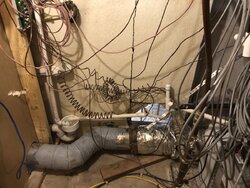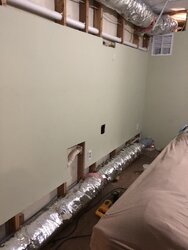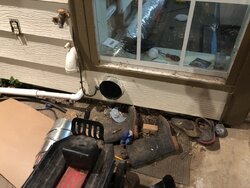Hello everyone! This is going to be a work in progress over the next few days. Some background: I work in the HVAC field and do almost all the design work for the company I work for (mainly residential and light commercial). I purchased an underground house a bit over a year ago. Had some very unsafe things going on. Fast forward to today I have ripped out old stand alone stove, rock wall that was built around it, the old pipe and the 4” single wall vent for the 80% furnace that ran next to it. I now have a summers heat 2k, class A pipe inside clay, double wall inside. Furnace is now 90+% vented out the side of the house (you can see the pvc in a pic). House itself has almost NO leakage verified by blower door. So that leads me to install a fresh air for the wood stove and house.
This first image shows the 6” to 3” reducer, the rigid flexible metal 6” pipe, and the aluminum waste gate. Thought the gate would be a nice safety feature for peace of mind. The wall pipe goes through is concrete board with metal studs (otherside is open to HVAC closet.)
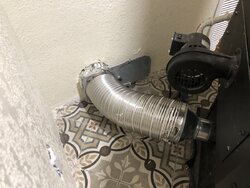
this second picture shows the 7” pipe (transition inside the HVAC closet) as it exits the HVAC closet and runs along the wall towards the exterior wall.
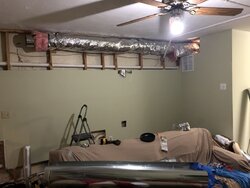
This 3rd picture you can see the exterior wall. I have to turn left Over the door and down out of the blue area. A central attic fan was installed here. I am now going to use that space to get both fresh air pipes and my kitchen exhaust pipe to the outside. Reason I have to exit here is because the rest of the house is either a load bearing beam or solid concrete. Yes, my ceiling is also concrete with 2’ of dirt on top.
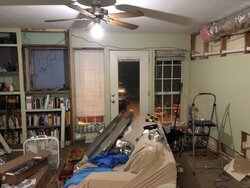
I am using either mastic tape or mud to seal all joints (even on the elbows). I decided to run 7” to reduce the chance of excessive pressure loss in the pipe. I’m using r6 insulation so I shouldn’t end up with condensation inside the pipe. Let me know what you think. I have to wait till tomorrow to finish so I built a fire as is. So far it doesn’t seem to make a difference with the pipe hooked up.
This first image shows the 6” to 3” reducer, the rigid flexible metal 6” pipe, and the aluminum waste gate. Thought the gate would be a nice safety feature for peace of mind. The wall pipe goes through is concrete board with metal studs (otherside is open to HVAC closet.)

this second picture shows the 7” pipe (transition inside the HVAC closet) as it exits the HVAC closet and runs along the wall towards the exterior wall.

This 3rd picture you can see the exterior wall. I have to turn left Over the door and down out of the blue area. A central attic fan was installed here. I am now going to use that space to get both fresh air pipes and my kitchen exhaust pipe to the outside. Reason I have to exit here is because the rest of the house is either a load bearing beam or solid concrete. Yes, my ceiling is also concrete with 2’ of dirt on top.

I am using either mastic tape or mud to seal all joints (even on the elbows). I decided to run 7” to reduce the chance of excessive pressure loss in the pipe. I’m using r6 insulation so I shouldn’t end up with condensation inside the pipe. Let me know what you think. I have to wait till tomorrow to finish so I built a fire as is. So far it doesn’t seem to make a difference with the pipe hooked up.



